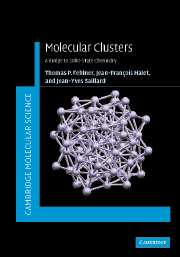Book contents
- Frontmatter
- Contents
- Preface
- 1 Introduction
- 2 Main-group clusters: geometric and electronic structure
- 3 Transition-metal clusters: geometric and electronic structure
- 4 Isolobal relationships between main-group and transition-metal fragments. Connections to organometallic chemistry
- 5 Main-group–transition-metal clusters
- 6 Transition to the solid state
- 7 From molecules to extended solids
- 8 Inter-conversion of clusters and solid-state materials
- Appendix: Fundamental concepts: a concise review
- Problem Answers
- References
- Index
- References
Appendix: Fundamental concepts: a concise review
Published online by Cambridge University Press: 19 February 2010
- Frontmatter
- Contents
- Preface
- 1 Introduction
- 2 Main-group clusters: geometric and electronic structure
- 3 Transition-metal clusters: geometric and electronic structure
- 4 Isolobal relationships between main-group and transition-metal fragments. Connections to organometallic chemistry
- 5 Main-group–transition-metal clusters
- 6 Transition to the solid state
- 7 From molecules to extended solids
- 8 Inter-conversion of clusters and solid-state materials
- Appendix: Fundamental concepts: a concise review
- Problem Answers
- References
- Index
- References
Summary
A chemist's approach to understanding matter is conveniently divided into three stages. First, fixed stoichiometric relationships between the atomic constituents of matter exist in molecular compounds and in many compounds with extended structures. Hence, the composition of a pure substance provides initial definition to a new substance. Given the atomic nature of substances, it provides direct information on structure. In a historical sense, other early means of characterization were physical ones, e.g., melting point or dipole moment, and sensual, e.g., color or taste. As a consequence, they are less directly related to structure. In the second stage, geometric relationships between the constituent atoms as well as spectroscopic and theoretical information on electronic structure add dimensions and shape to the composition data. Finally, reaction chemistry, i.e., reaction stoichiometries, rates and mechanisms, provides connections between compound types as well as generating new substances for which the whole process begins again.
Stable compounds are the most thoroughly characterized and provide the corpus of chemistry. However, “stability” is one of the definable, but casually used, terms of chemistry. Stability is associated with energy, and energy and structure are inextricably combined. A chemist, well educated in a given area, has a good understanding of both energy and structure. In a practical sense, stable for the inorganic chemist is often defined empirically by isolation and storage at room temperature. Most stable is often implied by the term, but it is not always clear that the most stable (thermodynamic) products have been characterized in a given reaction.
- Type
- Chapter
- Information
- Molecular ClustersA Bridge to Solid-State Chemistry, pp. 323 - 348Publisher: Cambridge University PressPrint publication year: 2007

